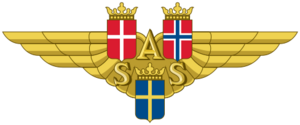Scandinavian Airlines facts for kids
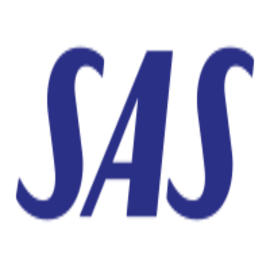
A Scandinavian Airlines Airbus A350
|
|
| Founded | 1 August 1946 |
|---|---|
| Commenced operations | 17 September 1946 |
| AOC # | SCA.AOC.001E |
| Hubs | |
| Focus cities |
|
| Frequent-flyer program | EuroBonus |
| Alliance |
|
| Subsidiaries |
|
| Fleet size | 135 (including subsidiaries and leases) |
| Destinations | 125 (including subsidiaries) |
| Parent company | SAS Group |
| Headquarters | SAS Frösundavik Office Building Solna, Stockholm County, Sweden |
| Key people | |
| Revenue | SEK 45,883 million (2024) |
| Profit | SEK 1,579 million (2024) |
Scandinavian Airlines, often called SAS, is a major airline for Denmark, Norway, and Sweden. It's like the national airline for these countries. SAS is part of the SAS Group and has its main office in Solna, Sweden.
As of July 2025, SAS and its smaller airlines, SAS Link and SAS Connect, fly 133 airplanes to 130 different places. Their main airport hub is Copenhagen Airport, which connects to 106 destinations around the world. They also have important hubs at Stockholm Arlanda Airport and Oslo Airport. Smaller hubs are located in Bergen, Gothenburg, Stavanger, and Trondheim.
In 2017, SAS carried over 28 million passengers. This made it one of the biggest airlines in Europe. The SAS fleet includes modern planes like the Airbus A320, Airbus A330, and Airbus A350. They also use planes from other companies through special rental agreements.
SAS was started in 1946. It was a partnership between the main airlines of Sweden, Norway, and Denmark. They joined forces to fly across the Atlantic Ocean. Later, they combined all their flights, and in 1951, they officially became one airline: SAS. In 1997, SAS helped start Star Alliance, which was the first big group of airlines working together. In 2024, SAS joined a different airline group called SkyTeam. This happened after new companies invested in SAS.
How SAS Started Flying
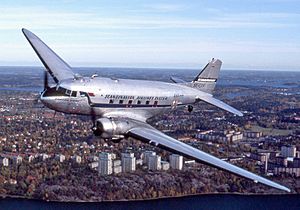
SAS began on August 1, 1946. Three airlines from Sweden, Denmark, and Norway decided to work together. They wanted to combine their flights across the world. The first president of SAS was Per Norlin. On September 17, 1946, SAS started its first international flight from Stockholm to New York. Soon after, SAS set a record by carrying a very heavy piece of cargo across the Atlantic.
In 1948, another Swedish airline joined SAS. By 1951, all these companies officially merged to form the SAS Consortium. When SAS was first created, the governments of Denmark, Norway, and Sweden owned half of the airline. Private investors owned the other half.
Flying Over the North Pole
In 1954, SAS made history by being the first airline to have regular flights over the North Pole. They flew Douglas DC-6B planes from Copenhagen to Los Angeles. These flights stopped in Greenland and Canada. This was a big step for air travel. Many Hollywood stars and movie people liked this new route. It also helped SAS get a lot of good attention.
In 1957, SAS was the first airline to offer flights around the world over the North Pole. They flew Douglas DC-7C planes from Copenhagen to Tokyo. These flights stopped in Alaska. This route was important because other countries would not let planes fly directly over Siberia.
The Jet Age Begins
In 1959, SAS started using jet planes. Their first jetliner was the French-built Sud Aviation Caravelle. The next year, they added the Douglas DC-8 jetliner to their fleet.
SAS also used new ways to make flying better for passengers. In 1965, it was the first airline to use an electronic system for booking flights. In 1971, SAS started using its first Boeing 747 jumbo jet. By 1982, SAS was known as the most on-time airline in Europe.
For many years, SAS also owned hotels. They built two large hotels in Copenhagen. They even opened a hotel in Kuwait. But in 1992, SAS sold its hotel chain. This happened because there was more competition in the airline business.

Growing and Partnering with Other Airlines
In 1981, Jan Carlzon became the CEO of SAS. He helped the company become financially strong again. SAS started buying or partly owning other airlines in Scandinavia. This included airlines in Norway, Sweden, and Denmark. In the 1990s, SAS also bought parts of British Midland and most of Spanair in Spain.
In the early 1990s, SAS tried to merge with other airlines like KLM and Swissair. But this big merger did not happen. In May 1997, SAS became a founding member of the Star Alliance network. This group included airlines like Air Canada, Lufthansa, and United Airlines.
In 2001, the ownership of SAS changed. The governments of Sweden, Norway, and Denmark owned parts of the company. The rest of the shares were sold to the public. In 2009, the different parts of SAS were brought back together into one company.
Changes and New Directions (2009-2025)
As more budget airlines appeared, SAS faced financial challenges. To save money, SAS sold its shares in other companies. They also worked to reduce their costs. In 2012, SAS had to make big changes. They reached an agreement with their employees to work longer hours and reduce salaries. This helped keep the airline flying.
In 2017, SAS created a new airline called Scandinavian Airlines Ireland. This airline flew European routes using newer planes. This helped SAS compete better with other airlines. In 2018, SAS ordered 50 more Airbus A320neo planes. This was part of their plan to use only Airbus planes in the future.
In July 2021, Sweden and Denmark provided financial support to SAS. In September 2021, SAS announced two new airline branches: SAS Connect and SAS Link. These started flying in early 2022.
In June 2022, the Swedish government announced it would not invest more money in SAS. On July 5, 2022, SAS filed for bankruptcy protection in the United States. This was a way for the company to reorganize its finances.
In October 2023, the Air France–KLM Group, the Danish government, and two investment companies announced plans to invest in SAS. This meant SAS would leave Star Alliance on August 31, 2024. The very next day, September 1, 2024, SAS joined SkyTeam, the same alliance as Air France–KLM. The US Bankruptcy Court approved this plan in March 2024.
In September 2024, SAS announced a new partnership with Braathens Regional Airlines (BRA). BRA will operate flights for SAS from Stockholm Arlanda Airport starting in 2025. This will help SAS strengthen its flights within Sweden. In September 2024, SAS also announced 15 new destinations from Copenhagen Airport starting in Summer 2025. This will make Copenhagen the airline's main hub for international travel.
On July 4, 2025, Air France-KLM announced they plan to increase their ownership in SAS to 60.5%.
About the Company
Business Information
Here are some key facts about the Scandinavian Airlines Group. This group includes SAS Cargo (for shipping goods), SAS Ground Handling (for airport services), and SAS Tech (for technology).
| Turnover (SEKm) |
Profit before tax (EBT) (SEKm) |
Number of employees (FTE) |
Number of passengers (m) |
Passenger load factor (%) |
Number of aircraft |
Notes/sources | |
|---|---|---|---|---|---|---|---|
| 2009 | 39,696 | −1,522 | 14,438 | 27.0 | 72.7 | 172 | |
| 2010 | 36,524 | −33 | 13,723 | 27.1 | 75.6 | 159 | |
| 2011 | 36,735 | 543 | 13,479 | 29.0 | 74.9 | 157 | |
| 2012 Jan-Oct |
33,148 | 228 | 13,591 | 25.9 | 76.7 | 156 | |
| 2013 | 42,182 | 1,648 | 14,127 | 30.4 | 75.0 | 151 | |
| 2014 | 38,006 | −918 | 12,329 | 29.4 | 76.9 | 156 | |
| 2015 | 39,650 | 1,417 | 11,288 | 28.1 | 76.3 | 151 | |
| 2016 | 39,459 | 1,431 | 10,710 | 29.4 | 76.0 | 156 | |
| 2017 | 42,654 | 1,725 | 10,324 | 30.1 | 76.8 | 158 | |
| 2018 | 44,718 | 2,041 | 10,146 | 30.1 | 75.7 | 157 | |
| 2019 | 46,112 | 794 | 10,445 | 29.8 | 75.2 | 158 | |
| 2020 | 20,513 | −10,097 | 7,568 | 12.6 | 60.5 | 135 | |
| 2021 | 13,958 | −6,525 | 5,216 | 7.6 | 46.7 | 129 | |
| 2022 | 31,824 | −7,846 | 7,033 | 17.9 | 69.6 | 134 | |
| 2023 | 42,043 | −5,516 | 7,959 | 23.7 | 75.4 | 134 |
Where is the Main Office?
Scandinavian Airlines' main office is in the SAS Frösundavik Office Building. This building is in Solna, Sweden, near Stockholm. The building was designed by Niels Torp Architects and built between 1985 and 1987.
Where SAS Flies
SAS has special agreements with other airlines. These are called codeshare agreements. This means you can book a flight with SAS, but actually fly on a plane from one of their partner airlines.
- Aegean Airlines
- All Nippon Airways
- Air Europa
- Air France
- Delta Air Lines
- Etihad Airways
- Icelandair
- KLM
- Korean Air
- Singapore Airlines
- Vietnam Airlines
- Virgin Atlantic
- Widerøe
SAS also has interlining agreements with other airlines. This means they can help you connect to flights on these airlines.
- Aerolineas Argentinas
- Air Greenland
- DAT
- Pakistan International Airlines
- WestJet
SAS Airplanes
Current Airplanes
As of March 2025, Scandinavian Airlines mainly uses Airbus planes.
| Aircraft | In service | Orders | Passengers | Notes | |||
|---|---|---|---|---|---|---|---|
| C | Y | M | Total | ||||
| Airbus A319-100 | 4 | — | — | — | 150 | 150 | One plane (OY-KBO) has a special old-style paint job. |
| Airbus A320-200 | 5 | — | — | — | 168 | 168 | |
| Airbus A320neo | 43 | 12 | — | — | 180 | 180 | More planes will be delivered until 2025. |
| Airbus A321LR | 3 | — | 22 | 12 | 123 | 157 | |
| Airbus A330-300 | 8 | — | 32 | 56 | 178 | 266 | |
| Airbus A350-900 | 4 | 2 | 40 | 32 | 228 | 300 | More planes will be delivered until 2026. |
| Embraer 195-E2 | — | 45 | TBA | Order with 10 options. | |||
| Total | 65 | 59 | |||||
SAS also operates one Boeing 737-700 for the Norwegian Armed Forces. This plane is used for medical flights. It will soon be replaced by an Airbus A320neo.
As of March 2025, SAS also uses planes operated by its smaller airlines and other companies.
| Aircraft | In service | Orders | Passengers | Notes | |||
|---|---|---|---|---|---|---|---|
| C | Y | M | Total | ||||
| Airbus A320neo | 30 | — | — | — | 180 | 180 | Operated by SAS Connect. |
| ATR 72-600 | 14 | — | — | — | 72 | 72 | Operated by Braathens Regional Airlines. |
| Bombardier CRJ900 | 5 | — | — | — | 88 | 88 | Operated by CityJet. |
| 9 | 90 | 90 | |||||
| Embraer E195 | 12 | — | — | — | 122 | 122 | Operated by SAS Link. |
| Total | 70 | — | |||||
Future Airplane Plans
Short Flights
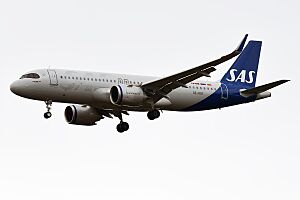
In June 2011, SAS ordered 30 new A320neo planes. Their goal was to have only Airbus planes at their Stockholm and Copenhagen bases by 2019. In April 2018, SAS ordered 50 more A320neos. This was to replace all their older Boeing 737s and A320s. The last Boeing 737 left the SAS fleet on November 19, 2023.
Long Flights
In June 2013, SAS decided to buy twelve new long-haul planes. This included eight A350-900s and four A330-300Es. The first new long-haul plane to start flying was the A330-300E. This helped SAS add more long-haul destinations.
The first 6 of 8 Airbus A350-900s for SAS were delivered in 2019. They started flying long-haul routes in 2020. The A350s first flew between Copenhagen and Chicago. SAS plans to use them for flights to Beijing, New York, Tokyo, Shanghai, Hong Kong, and San Francisco as more A350s arrive.
Airplane Colors and Design
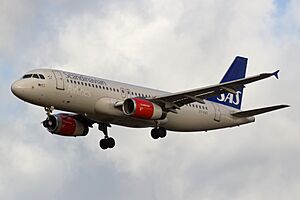
In September 2019, SAS showed off a brand new design for its planes. This new look will be on all planes by 2024. The main part of the plane is a light beige color. The word "SAS" is big and silver on the front. The tail and nearby parts are blue, with the white SAS logo on the tail. The word "Scandinavian" is also written in large blue letters on the bottom of the plane. The engine covers are beige with a blue stripe and the word "Scandinavian" in blue.
The previous design was from 1998. Those planes were mostly white with "Scandinavian" in silver above the windows. The tail was blue with the classic white SAS logo. The engine covers were red with "Scandinavian" in white. All SAS planes are named, usually after Vikings.
Besides the new and old designs, SAS also has one Airbus A319-100 with a special retro (old-style) paint job.
Inside the Plane: Cabin Classes
SAS Business
On long flights, SAS offers SAS Business class. These seats are wide and turn into flat beds. On the A330s and A350s, the seats are arranged 1-2-1. They become flat beds that are about 196-202 cm long. They also have power outlets and a 15-inch entertainment screen. On the A321LRs, business class seats are arranged 2-2 and 1-1, and they also turn into flat beds.
SAS Plus
Plus is SAS's premium economy class. On the A330s, seats are 2-3-2. On the A350s, they are 2-4-2. On the A321LR, they are 2-2. These seats are wider than those in SAS Go.
On flights within Europe, SAS Plus tickets can be refunded. They also include a meal, extra baggage allowance, and access to airport lounges and faster security lines. SAS Plus passengers sit at the front of the plane and can choose their seat for free when booking.
SAS Go
SAS Go is the economy class. On flights within Europe, seats are 3-3. On the A330s, they are 2-4-2, and on the A350s, they are 3-3-3.
SAS offers free coffee and tea to Go passengers on short flights. Meals are served to all passengers on long flights.
SAS Go Light
SAS Go Light is a version of SAS Go. The main difference is that it does not include checked luggage. It's for people who only travel with carry-on bags. This option helps SAS compete with airlines that offer very low prices.
Services for Passengers
EuroBonus Program
SAS has a program for frequent flyers called EuroBonus. Members earn points when they fly with SAS or its partners. About half of SAS's total money comes from EuroBonus members. By August 2015, over four million people were EuroBonus members.
Wi‑Fi on Board
In May 2018, SAS started offering new high-speed Wi‑Fi Internet on its planes. This system allows passengers to stream movies. Wi‑Fi is free for EuroBonus Gold and Diamond members and those with Business class tickets. Others can buy Wi‑Fi using EuroBonus points or money.
Incidents and Advertising
Advertising Campaign Controversy
On February 10, 2020, SAS released a commercial called "What is truly Scandinavian?". This video talked about how global ideas and inventions have influenced Scandinavia. Some groups were upset by this, feeling it disrespected Scandinavian culture. SAS stated they would continue with the campaign.
On February 13, 2020, SAS offices and the advertising agency received threats. Later, a shorter version of the commercial was put on Facebook, and the original YouTube video was made private.
See also
 In Spanish: Scandinavian Airlines System para niños
In Spanish: Scandinavian Airlines System para niños
- SAS Group
- Norwegian Aviation College
- List of airports in Denmark, Norway, and Sweden
- List of the busiest airports in the Nordic countries
- Transport in Denmark, Norway, and Sweden


